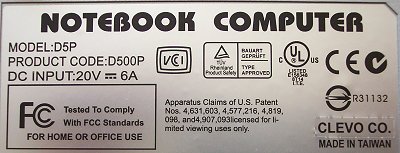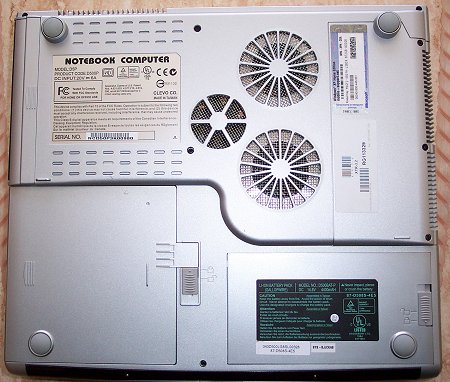Specifications and appearance
| System Name | Rock Xtreme XTR-3.2 |
| Processor | Intel Pentium 4 3.2GHz desktop 200MHz CPU (Northwood) |
| Motherboard | Intel i865PE (dual-channel support) |
| Memory | 512MB (2 x 256MB PC3200 SODIMMs) |
| Hard Drive | Fujitsu MHT2080AT 80GB 4,200RPM |
| Screen | 15" SXGA+ (1400x1050) |
| Graphics card | ATI Mobility Radeon 9600 Turbo Pro 128MB (345/470) |
| Optical drive | Sony DW-U50A |
| Optical drive characteristics | DVD-R, DVD+R, DVD+RW, DVD-RW, CD-R, CD-RW, DVD (read), CD-R (read), PowerBurn |
| Sound | ICH5 audio through Realtek CODEC |
| Modem | Smart Link 56k |
| Network | Realtek 8169 Gigabit LAN, MSI 802.11a/b/g WLAN, Bluetooth |
| Operating system | Windows XP Home SP1 |
| Weight | 4.1kg (without charger) |
| Dimensions | 33cm (w) x 29cm (d) x 4.4cm (h) |
| Warranty | Rockdirect 3-year collect-and-return |
| Price | £1806 inc. VAT (as at 17/03/04) |
| Shipping | £23.75 |
It used to be the case that once you decided on what kind of laptop you required, you'd peruse through a catalogue and pick a ready-made design. That, thankfully isn't the case now, for any self-respecting company that's dealing with power laptops allows the user to fully customise the internal specifications. What we're looking at is Rock's thoughts on how to engineer a decent power notebook.

Clevo's badge on the back shows that Rock buys in at least the shell from the Taiwanese manufacturer. Looking through Clevo's 'site we see that the D500P model can be equipped with every component available in Rock's Xtreme range. Indeed, Rock's specification manipulation only extends to peripherals and components that can be easily changed on the production line, such as the CPU, memory, hard drive and optical drive. Rock's configuration menu for the XTR-3.2 is shown here. We're adamant that the shell and motherboard are bought in as a bundle. That's not a major criticism, as there's numerous other U.K-based companies doing the same thing. Rock has a trick up its sleeve that the others can't much, however.
Looking at the review model, a 3.2GHz Pentium 4 200MHz Front-side bus Northwood processor is used to provide some serious oomph. Our major problem with its choice lies in the desktop heritage and attributes, namely its wattage-eating ability. The spec. sheet looks far more like a desktop's, such is the advancement in mobile(ish) power computing. Rock uses a Clevo-supplied Intel i865PE Springdale motherboard which is cut down for laptop use. That infers dual-channel memory support at DDR400 speeds. That's exactly what Rock opts for, but 512MB (2 x 256MB) seems a little stingy in a laptop geared for all-out performance.
Keeping up the power theme is ATI's Mobility Radeon 9600 Pro 128MB card. ATI's naming structure leaves a lot to be desired. There's the standard MR9600, MR9600 Pro, and now the MR9600 Turbo Pro. Memory speed and size dictate which nomenclature is valid. Considering the Rock Xtreme's card is an 128MB model with 345/470 clocks, it's safe to call it a Mobility Radeon 9600 Turbo Pro. Confusing, you bet!. Dell, amongst others, is now shipping the MR 9700 with its Inspiron 9100 range of beefy laptops, although the MR9600 remains a solid gaming card.

Rock's opted for a Fujitsu 80GB hard drive. Sounds good on paper. However, the drive spins at a slow 4,200RPM. We'd have preferred either one of the newer 5,400RPM 80GB drives or, as with the Voodoo PC laptop, a 60GB 7,200RPM drive. You can sense the Fujitsu's slugishness in Windows. Things look up in the optical department. Sony's DW-U50A dual-format DVD-ReWriter is a jack of all trades, being able to write both - and +r, as well as the usual CD burning and DVD playback. There's also an Infra-red transceiver just above. Clevo allows the use of a 6-in-1 card reader, 2nd battery, 2nd optical drive or 2nd hard drive in lieu of the floppy drive. Given the base spec. here, we'd have taken a card reader instead.

It's port heaven on the back. Rock/Clevo provide a security lock on the very far left-hand side; a nice touch. Audio ports next, with Mic-In, Headphone-Out, and S/PDIF-Out jacks. The common, on laptops at least, 4-pin FireWire port's next. It's flanked by modem and Ethernet jacks, with the Ethernet being run off a Realtek Gigabit (8169) ASIC. We've seen these on a number of full-size boards. The ubiquitous S-Video socket sits next to VGA-Out and the archaic Parallel port. Finally, a PS/2 port can take either a keyboard or mouse. There's also sufficient cooling here, for the CPU sits close by. What we can't see are the integrated 54g WLAN and Bluetooth devices, which are incorporated inside the chassis.

The other side has a regular PCMCIA slot and the charger's conduit. Plenty of cooling fins are present. You'll see why lower down.

The front continues the bulky chassis theme. Here, however, Rock uses a small LCD and a collection of buttons that allow for music (CD-based) playback when the laptop is switched off (obviously it still needs either a battery or AC power source).

Sound quality is surprisingly good for laptop speakers. Volume and track selection can both be adjusted. It's not as gimmicky as it sounds (bad pun).

Cooling a desktop 3.2GHz Pentium 4 is no easy task, and made that much harder by the confines imposed by a laptop's chassis. Rock/Clevo use three fans for heat removal work. The raised feet serve an important purpose - they force a gap between the chassis' bottom and where the laptop would be situated. Enough of a gap to ensure that the fans can do their work. That's good design. The downside of three fans is noise. When plugged to the mains and running full throttle the Rock Xtreme sounds like a mini vacuum cleaner. It's not distressingly loud by any means, but neither is it quiet, and it's louder than Voodoo PC's laptop.









